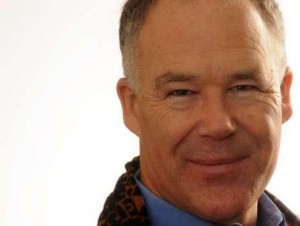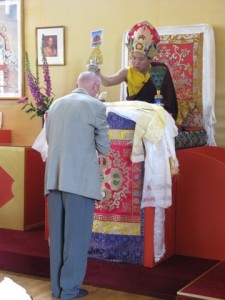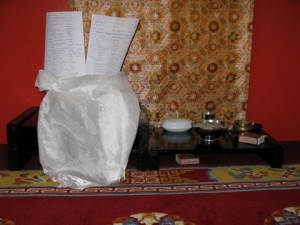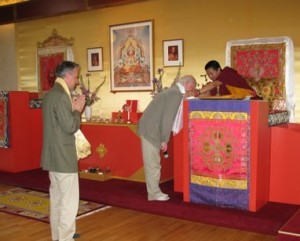Tuesday
Community Articles, Featured StoriesPart 2: Healing in the Space Between Languages and Sanghas
…continued from Part 1 by Timothy Walker.Then there is the wonderfully quirky way that Tibetans pronounce what we think we know as Sanskrit. The most famous of these quirky pronunciations is of course Benza for what we know as Vajra. There are many more examples of this including several in the Medicine Buddha mantra itself. Many times, I found myself switching over to my more familiar pronunciations, to then, at some point, switch back when the force of the group and teacher’s example seemed to be urging me to conform. I believe I heard a few other Shambhalians doing the same.
I contemplated the meaning of this experience as both a subtle resistance and an enjoyment of practicing in another language as it applies to healing. Several insights flew by. One has to do with our attachment to the forms we practice altogether. Of course, the forms of the practice are meant to guide and carry us along like the famous ferryboat that takes us across the river. Having arrived on the other side, we can release our attachment to the boat and the river. What emerged was a delightful practice underneath the formal recitation as I related to my attachment of what I thought to be the “right way” – then watching as this silly mindset dissolved in this joyful mandala. And going back and forth from Tibetan to English — with a smattering of French and German thrown in — profoundly jostled my very attachment to language altogether. I found myself swimming in a sea of rhythm and meaning regardless of what language was flowing by. This aroused a feeling of being in a kind of bardo between form and emptiness, a wobbly and shifty world of no form or one of flexible and changing forms. This felt pretty good and again I realized this place is called Dechen Choling for good reason.
The other way I contemplated, while floating, a bit blissed-out by this fuzzy realm between languages, was to examine my awareness of how our two distinct sanghas were blending. For sure there were resistances and cliques and pockets of fixation but there was also a sweet and genuine curiosity and enjoyment of one another’s differences. Then it struck me how these blending sanghas were so like two families brought together by marriage, and indeed that is exactly what they are. I reflected on how, as a couple’s counselor, I have been with many couples struggling with their distaste, intolerance, and even hatred for in-laws. It’s a funny thing because on the surface we all profess to be open minded and tolerant. But when it comes to deeply ingrained family patterns, simple preferences, and forms of communication, we can behave like a pack of wild dogs defending our territory. This got me thinking about how, at a wedding there may be signs and symbols of inter-familial turmoil and even some brief flare-ups, but if you give it a few years, you can then really see how the challenges of blending families manifests. Our royal couple was first married in Boulder four years ago this summer. I think back with a smile to that celebration and to the one in Halifax a year later as archetypal events that have profoundly altered the landscape of Shambhala. It is of course natural that some people might resist these changes in the same way I found myself resisting the Tibetan pronunciation of Sanskrit mantras. I think particularly in Halifax after the Gesar Festival of 2007 when there was a general disappointment that Penor Rinpoche could not come to convey the Sakyong Wangmo empowerment. Some began wondering “who is this family that we are now married to,” and “how much influence will they have in our community?”
What fascinates me however is that at the Gesar festival held at Dechen Choling that same summer, a very different environment unfolded. From what I can tell in talking to many others there was a genuine sense of delight and Celebration in the coming together of the Sakyong’s teachings with those of His Eminence Namkha Drimed Rinpoche and Jigme Rinpoche and a delight in the mingling of the Sanghas. Not that I want to oversimplify or overgeneralize the difference between these two events because of course there are at least as many perspectives as there were people at the events. I do think nonetheless, it has been instructive for me to see how in Europe, where people are used to a tremendous diversity of languages and cultures mixing and blending there was perhaps a more natural sense of assimilation of our new family while in the capital of Shambhala there might have been a bit more nostalgia for the old ways.As a desung, I have spent the last year or so contemplating the phrase “protecting primordial harmony.” Because the ultimate harmony in the sangha — like Basic Goodness or the Ka of kasung — is primordial, it has no need for protection. This primordial harmony is self-existing and outside of relative conditions. Our mandate as desung is to protect the access to the De, the harmony or bliss. This access does exist in our relative world and therefore has ups and downs due to relative conditions and human neurosis. An awareness of these causes and conditions and these fluctuations in harmony or disharmony is sometimes all that is necessary in the practice of being a desung. From this awareness, a naturally organic process of engagement will follow. Harmony, I have thought, is also a wonderful term in that it implies different pitches blending into a pleasant sound. While practicing in Tibetan instead of only English and saying Benza instead of Vajra provoked my irritation and sense of pride and identity, in the end I grew by working with this irritation and playing with the boundaries of my expectations. It was also fun to be a beginner again and experience a different teacher.
I was especially moved when Jigme Rinpoche practiced with us, which happened at least once daily. Similar to what I have noticed when Mipham Rinpoche joins us for practice in Halifax, I felt as if there was a powerfully structured field of mind that opened up a space for deeper and more precise practice. Looking up at the throne during mantra recitation, I was moved to see and sense the intensity of what I perceived to be his bodhisattva intention — it seemed to powerfully hold us as a room full of blue Medicine Buddhas. It then continued to see us that way while sending healing energy to us and universally outward to everyone everywhere. To me, he seemed focused and committed, practicing with every cell of his body aligned with this intention. He also gave some wonderful talks that bridged the practical with the profound, joining heaven and earth in the practice of healing.One of the wonderful things about the Medicine Buddha practices is that although they are fully vajrayana in style, there is a long-held tradition of giving them away to students who show an interest and need, but who may not have done preliminary practices or received transmissions. I surmise this is because of the great benefit that can be reaped through the practice and the universal need for healing. I know that Thrangu Rinpoche and many other lamas also encourage this, and in a similar way, the Sakyong wrote and offered the short healing practice of White Tara, which is available to all practitioners.
Healing has been a theme in my life ever since I went to Naropa and met Trungpa Rinpoche. In recent years I have become interested in how healing might be contemplated and practiced at the level of a society altogether. How do we grow, learn and heal as an Enlightened Society in Shambhala. The comedies of classical theater nearly always end with weddings as archetypes of regeneration, peace and harmony. They also poke fun at the dramas of human folly in love and the resistance to love. For me, being at this retreat was healing on many levels. I saw how our new in-laws simultaneously enrich and challenge us with their differences. I think when we realize that as a sangha we can have a sense of humor about our own resistances, then we can join them in a celebration of the journey to a higher level of harmony.
Just before and during our closing feast I wrote the following poem of praise to the Medicine Buddha and read it aloud to the assembly as part of that celebration.
Click here to read Medicine Buddha Aspirations, a poem by Timothy Walker.
__________________________
 Trained in the Psychology of Meditation, Contemplative Psychotherapy, Family Systems, and Transactional Analysis, Timothy Walker, PhD has 30 years experience integrating mindfulness into counseling, psychotherapy, consulting, healthcare and education. Dr. Walker founded the EastWind Stress Reduction Clinic based on the mindfulness model developed by Jon Kabat-Zinn. With Dr. Rob Rutledge of the Nova Scotia Cancer Centre, he developed the Skills for Healing weekend retreats for people living with cancer and the Skills for Wellness programs for health professionals. For the last ten years, they have presented these programs in multiple cities across Canada and have recently formed Healing and Cancer, a charitable foundation to support this work and have a forthcoming book —Healing And Cancer: Integrating Science Wisdom and Compassion on the Path to Wholeness.
Trained in the Psychology of Meditation, Contemplative Psychotherapy, Family Systems, and Transactional Analysis, Timothy Walker, PhD has 30 years experience integrating mindfulness into counseling, psychotherapy, consulting, healthcare and education. Dr. Walker founded the EastWind Stress Reduction Clinic based on the mindfulness model developed by Jon Kabat-Zinn. With Dr. Rob Rutledge of the Nova Scotia Cancer Centre, he developed the Skills for Healing weekend retreats for people living with cancer and the Skills for Wellness programs for health professionals. For the last ten years, they have presented these programs in multiple cities across Canada and have recently formed Healing and Cancer, a charitable foundation to support this work and have a forthcoming book —Healing And Cancer: Integrating Science Wisdom and Compassion on the Path to Wholeness.








Aug 24, 2010
Reply
Wonderful, thanks for sharing this. I was at the Gesar Festival at Dechen Choling. Inspiring to read your insights.